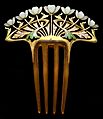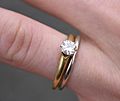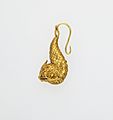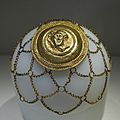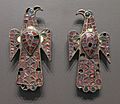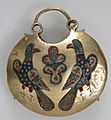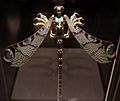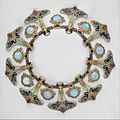Jewellery facts for kids
Jewellery (or jewelry) means small, pretty things people wear to decorate themselves. These can be brooches, rings, necklaces, earrings, pendants, bracelets, and cufflinks. You can wear jewellery on your body or attach it to your clothes. It's usually made from strong materials, so things like fresh flowers aren't usually called jewellery.
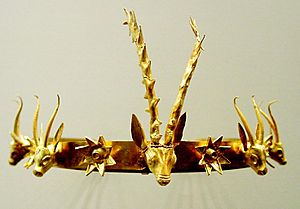
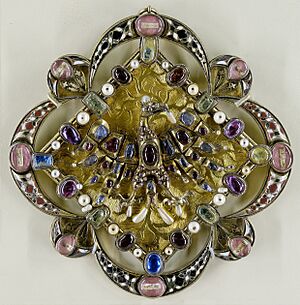
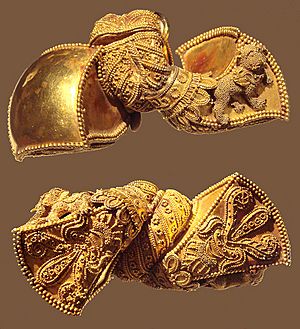
For a long time, jewellery has often been made from metal, usually with sparkling gemstones. But people also use other materials like shells or parts of plants. Jewellery is one of the oldest things found by archaeologists. The oldest known pieces are 100,000-year-old beads made from Nassarius shells!
The basic shapes of jewellery are different in various cultures, but they often last for a very long time. In European cultures, common types like rings and necklaces have been around since ancient times. Other types, like nose or ankle ornaments, are very important in some cultures but less common in Europe.
Jewellery can be made from many different things. Gemstones like amber and coral are popular. Precious metals, beads, and shells are also widely used. Enamel, which is like a colourful glass coating, has also been important.
In most cultures, jewellery can show a person's social status. This can be because of the materials it's made from, its designs, or special symbols it carries. Jewellery has been made to decorate almost every part of the body, from hairpins to toe rings. How much jewellery men, women, and children wear can be very different across cultures. However, adult women have always worn jewellery consistently. In modern European culture, men wear much less jewellery compared to other cultures or past times in Europe.
Contents
Why People Wear Jewellery
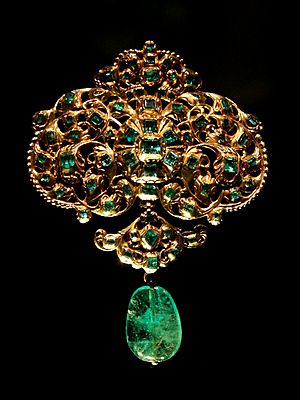
People have worn jewellery for many different reasons throughout history:
- To be useful: Sometimes, jewellery helps hold clothes or hair in place.
- To show status: It can show a person's social status or personal situation, like a wedding ring shows someone is married.
- To show belonging: Jewellery can show you belong to a certain group, like a family, religion, or club. Examples include a Christian crucifix or a Jewish Star of David.
- For protection: Some people wear amulets or devotional medals for good luck or to keep bad things away. These can be symbols like the ankh, special stones, or even parts of the body like the Khamsa.
- As art: Jewellery can simply be a beautiful piece of art to display.
- To carry meaning: It can hold special personal meaning, like showing love, remembering someone, or even bringing luck.
Many cultures have also used jewellery to store wealth. For example, some cultures keep wedding dowries (gifts given at a wedding) as jewellery. Jewellery has also been used as a form of money or something to trade.
Some jewellery items, like brooches and buckles, started out as useful things. But over time, as their practical use became less important, they turned into decorative items.
A Look Back: The History of Jewellery
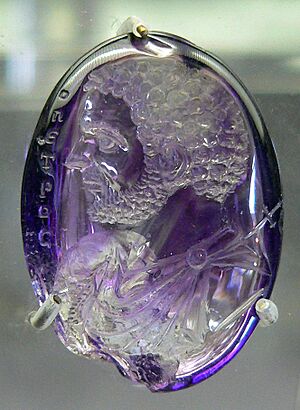
The history of jewellery is very long, going back thousands of years! Different cultures have used it in many ways. Studying ancient jewellery helps us understand how people lived long ago.
Jewellery can be made from almost any material. The very first jewellery was made from things like bones, animal teeth, wood, or stone. Today, jewellery often uses sparkling gemstones and precious metals like gold and silver.
Sometimes, you might hear about fashion jewellery or costume jewellery. This type of jewellery is worn just for fashion and is not made from expensive materials.
Common Types of Jewellery
Here are some common types of jewellery people wear:
- Earrings: These are any pieces of jewellery worn on the ears.
- Necklaces: Worn around the neck.
- Rings: These include finger rings (usually just called "rings") and toe rings.
- Bracelets or bangles: Worn on the wrists.
- Arm rings or armlets: Worn on the upper arms.
- Pins or Brooches: Worn on clothes for decoration or to keep clothes fastened.
- Piercings: This is jewellery that is put through small holes made in the skin.
Images for kids
-
A beautiful hair ornament, an Art Nouveau masterpiece by René Lalique, from around 1902. It's made of gold, emeralds, and diamonds.
-
A Khmissa amulet made of silver.
-
A headdress decorated with golden leaves, from 2600–2400 BC. It's made of gold, lapis lazuli, and carnelian.
-
The Great Cameo of France, from the early 1st century AD. It's a large carving on five layers of sardonyx.
-
A Byzantine necklace from the late 6th–7th century, made in a Constantinopolitan workshop. It features gold, emeralds, sapphires, amethysts, and pearls.
-
A breastplate with peacocks by René Lalique, from around 1898–1900. It's made of gold, enamels, opals, and diamonds.
-
Moche ear jewellery from the 3rd–7th century, made of gold, turquoise, sodalite, and shell.
-
Bai-De-Schluch-A-Ichin, also known as Be-Ich-Schluck-Ich-In-Et-Tzuzzigi (Slender Silversmith), a Navajo silversmith, photographed in 1883.
-
Indian actress Shraddha Kapoor showing off modern Indian-style jewellery.
-
A string of beads from 3650–3100 BC, made by Naqada II or Naqada III cultures. It features lapis lazuli (blue beads) and travertine (white beads).
-
A string of beads from 3300–3100 BC, made by Naqada III culture. It includes carnelian, garnet, quartz, and glazed steatite.
-
An armlet with a sun symbol from the late Bronze Age (16th-13th century BC), made of bronze.
-
A necklace, probably from 2600–1300 BC, found at Saruq Al Hadid in the United Arab Emirates. It's made of carnelian, bone, and stone.
-
A pectoral (chest jewellery) belonging to Tutankhamun, from 1336–1327 BC. It's made of gold, silver, and meteoric glass.
-
A pectoral and necklace belonging to Princess Sithathoriunet, from 1887–1813 BC. It features gold, carnelian, lapis lazuli, turquoise, garnet, and feldspar.
-
A necklace from 2600–2500 BC, found at the Royal Cemetery at Ur (Iraq). It's made of gold and lapis lazuli.
-
An openwork hairnet with the head of Medusa from 200–300 AD, made of gold.
-
The Eagle-shaped fibulae of Alovera from the 5th century, found in Guadalajara (Spain). They are made of gold, bronze, and glass.
-
Shoulder-clasps from Sutton Hoo from the early 7th century, made of gold, glass, and garnet.
-
The front of a temple pendant with two birds next to a tree of life, from the 11th–12th century. It was made in Kyiv (Ukraine) using cloisonné enamel and gold.
-
The Dragonfly brooch by René Lalique, from around 1897–1898. It's made of gold, vitreous enamel, chrysoprase, chalcedony, moonstone, and diamond.
-
A hair ornament, an Art Nouveau masterpiece by René Lalique, from around 1902. It's made of gold, emeralds, and diamonds.
-
Xin 心 shaped jewellery from 1368–1644, found in Dingling (Beijing, China). It's made of gold, ruby, pearl, and other gemstones.
-
A pendant, possibly showing a Siddha, from the 8th–9th century, made of copper alloy.
-
An earring showing four-armed Vishnu riding Garuda with Nagas (serpent divinities), from around 1600, from Nepal. It's repousse gold with pearls.
-
A pair of Maya earflare frontals from the 3rd–6th century, made of jade (jadeite).
-
A pendant with two bat-head warriors carrying spears, from the 11th–16th century. It's made of gold and found in the Chiriqui Province (Panama).
-
A Double-headed serpent from 1450–1521, made of Spanish cedar wood, turquoise, shell, and traces of gilding.
-
A Māori hei-tiki from 1500–1800, from New Zealand. It's made of jade (nephrite), abalone shell, and pigments.
See also
 In Spanish: Joyería para niños
In Spanish: Joyería para niños



